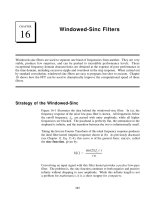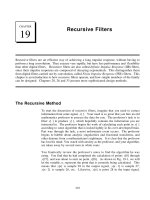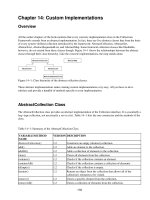Custom Filters
Bạn đang xem bản rút gọn của tài liệu. Xem và tải ngay bản đầy đủ của tài liệu tại đây (364.03 KB, 14 trang )
297
CHAPTER
17
Custom Filters
Most filters have one of the four standard frequency responses: low-pass, high-pass, band-pass
or band-reject. This chapter presents a general method of designing digital filters with an
arbitrary frequency response, tailored to the needs of your particular application. DSP excels
in this area, solving problems that are far above the capabilities of analog electronics. Two
important uses of custom filters are discussed in this chapter: deconvolution, a way of restoring
signals that have undergone an unwanted convolution, and optimal filtering, the problem of
separating signals with overlapping frequency spectra. This is DSP at its best.
Arbitrary Frequency Response
The approach used to derive the windowed-sinc filter in the last chapter can
also be used to design filters with virtually any frequency response. The only
difference is how the desired response is moved from the frequency domain into
the time domain. In the windowed-sinc filter, the frequency response and the
filter kernel are both represented by equations, and the conversion between
them is made by evaluating the mathematics of the Fourier transform. In the
method presented here, both signals are represented by arrays of numbers, with
a computer program (the FFT) being used to find one from the other.
Figure 17-1 shows an example of how this works. The frequency response
we want the filter to produce is shown in (a). To say the least, it is very
irregular and would be virtually impossible to obtain with analog
electronics. This ideal frequency response is defined by an array of
numbers that have been selected, not some mathematical equation. In this
example, there are 513 samples spread between 0 and 0.5 of the sampling
rate. More points could be used to better represent the desired frequency
response, while a smaller number may be needed to reduce the computation
time during the filter design. However, these concerns are usually small,
and 513 is a good length for most applications.
The Scientist and Engineer's Guide to Digital Signal Processing298
100 'CUSTOM FILTER DESIGN
110 'This program converts an aliased 1024 point impulse response into an M+1 point
120 'filter kernel (such as Fig. 17-1b being converted into Fig. 17-1c)
130 '
140 DIM REX[1023] 'REX[ ] holds the signal being converted
150 DIM T[1023] 'T[ ] is a temporary storage buffer
160 '
170 PI = 3.14159265
180 M% = 40 'Set filter kernel length (41 total points)
190 '
200 GOSUB XXXX 'Mythical subroutine to load REX[ ] with impulse response
210 '
220 FOR I% = 0 TO 1023 'Shift (rotate) the signal M/2 points to the right
230 INDEX% = I% + M%/2
240 IF INDEX% > 1023 THEN INDEX% = INDEX%-1024
250 T[INDEX%] = REX[I%]
260 NEXT I%
270 '
280 FOR I% = 0 TO 1023
290 REX[I%] = T[I%]
300 NEXT I%
310 ' 'Truncate and window the signal
320 FOR I% = 0 TO 1023
330 IF I% <= M% THEN REX[I%] = REX[I%] * (0.54 - 0.46 * COS(2*PI*I%/M%))
340 IF I% > M% THEN REX[I%] = 0
350 NEXT I%
360 ' 'The filter kernel now resides in REX[0] to REX[40]
370 END
TABLE 17-1
Besides the desired magnitude array shown in (a), there must be a
corresponding phase array of the same length. In this example, the phase
of the desired frequency response is entirely zero (this array is not shown
in Fig. 17-1). Just as with the magnitude array, the phase array can be
loaded with any arbitrary curve you would like the filter to produce.
However, remember that the first and last samples (i.e., 0 and 512) of the
phase array must have a value of zero (or a multiple of 2B, which is the
same thing). The frequency response can also be specified in rectangular
form by defining the array entries for the real and imaginary parts, instead
of using the magnitude and phase.
The next step is to take the Inverse DFT to move the filter into the time
domain. The quickest way to do this is to convert the frequency domain to
rectangular form, and then use the Inverse FFT. This results in a 1024
sample signal running from 0 to 1023, as shown in (b). This is the impulse
response that corresponds to the frequency response we want; however, it
is not suitable for use as a filter kernel (more about this shortly). Just as
in the last chapter, it needs to be shifted, truncated, and windowed. In this
example, we will design the filter kernel with , i.e., 41 pointsM ' 40
running from sample 0 to sample 40. Table 17-1 shows a computer program
that converts the signal in (b) into the filter kernel shown in (c). As with
the windowed-sinc filter, the points near the ends of the filter kernel are so
small that they appear to be zero when plotted. Don't make the mistake of
thinking they can be deleted!
Chapter 17- Custom Filters 299
Time Domain
Frequency
0 0.1 0.2 0.3 0.4 0.5
0
1
2
3
a. Desired frequency response
Sample number
0 256 512 768 1024
-0.5
0.0
0.5
1.0
1.5
b. Impulse response (aliased)
1023
Frequency
0 0.1 0.2 0.3 0.4 0.5
0
1
2
3
d. Actual frequency response
Sample number
0 10 20 30 40 50
-0.5
0.0
0.5
1.0
1.5
c. Filter kernel
1023
added
zeros
Frequency Domain
FIGURE 17-1
Example of FIR filter design. Figure (a) shows the desired frequency response, with 513 samples running
between 0 to 0.5 of the sampling rate. Taking the Inverse DFT results in (b), an aliased impulse response
composed of 1024 samples. To form the filter kernel, (c), the aliased impulse response is truncated to M%1
samples, shifted to the right by samples, and multiplied by a Hamming or Blackman window. In thisM/2
example, M is 40. The program in Table 17-1 shows how this is done. The filter kernel is tested by padding
it with zeros and taking the DFT, providing the actual frequency response of the filter, (d).
Amplitude Amplitude
AmplitudeAmplitude
The last step is to test the filter kernel. This is done by taking the DFT (using
the FFT) to find the actual frequency response, as shown in (d). To obtain
better resolution in the frequency domain, pad the filter kernel with zeros
before the FFT. For instance, using 1024 total samples (41 in the filter kernel,
plus 983 zeros), results in 513 samples between 0 and 0.5.
As shown in Fig. 17-2, the length of the filter kernel determines how well the
actual frequency response matches the desired frequency response. The
exceptional performance of FIR digital filters is apparent; virtually any
frequency response can be obtained if a long enough filter kernel is used.
This is the entire design method; however, there is a subtle theoretical issue
that needs to be clarified. Why isn't it possible to directly use the impulse
response shown in 17-1b as the filter kernel? After all, if (a) is the Fourier
transform of (b), wouldn't convolving an input signal with (b) produce the exact
frequency response we want? The answer is no, and here's why.
The Scientist and Engineer's Guide to Digital Signal Processing300
When designing a custom filter, the desired frequency response is defined by
the values in an array. Now consider this: what does the frequency response
do between the specified points? For simplicity, two cases can be imagined,
one "good" and one "bad." In the "good" case, the frequency response is a
smooth curve between the defined samples. In the "bad" case, there are wild
fluctuations between. As luck would have it, the impulse response in (b)
corresponds to the "bad" frequency response. This can be shown by padding
it with a large number of zeros, and then taking the DFT. The frequency
response obtained by this method will show the erratic behavior between the
originally defined samples, and look just awful.
To understand this, imagine that we force the frequency response to be what
we want by defining it at an infinite number of points between 0 and 0.5.
That is, we create a continuous curve. The inverse DTFT is then used to
find the impulse response, which will be infinite in length. In other words,
the "good" frequency response corresponds to something that cannot be
represented in a computer, an infinitely long impulse response. When we
represent the frequency spectrum with samples, only N points areN/2 % 1
provided in the time domain, making it unable to correctly contain the
signal. The result is that the infinitely long impulse response wraps up
(aliases) into the N points. When this aliasing occurs, the frequency
response changes from "good" to "bad." Fortunately, windowing the N
point impulse response greatly reduces this aliasing, providing a smooth
curve between the frequency domain samples.
Designing a digital filter to produce a given frequency response is quite simple.
The hard part is finding what frequency response to use. Let's look at some
strategies used in DSP to design custom filters.
Deconvolution
Unwanted convolution is an inherent problem in transferring analog
information. For instance, all of the following can be modeled as a
convolution: image blurring in a shaky camera, echoes in long distance
telephone calls, the finite bandwidth of analog sensors and electronics, etc.
Deconvolution is the process of filtering a signal to compensate for an
undesired convolution. The goal of deconvolution is to recreate the signal as
it existed before the convolution took place. This usually requires the
characteristics of the convolution (i.e., the impulse or frequency response) to
be known. This can be distinguished from blind deconvolution, where the
characteristics of the parasitic convolution are not known. Blind deconvolution
is a much more difficult problem that has no general solution, and the approach
must be tailored to the particular application.
Deconvolution is nearly impossible to understand in the time domain, but
quite straightforward in the frequency domain. Each sinusoid that composes
the original signal can be changed in amplitude and/or phase as it passes
through the undesired convolution. To extract the original signal, the
deconvolution filter must undo these amplitude and phase changes. For
Chapter 17- Custom Filters 301
Frequency
0 0.1 0.2 0.3 0.4 0.5
0
1
2
3
a. M = 10
Frequency
0 0.1 0.2 0.3 0.4 0.5
0
1
2
3
c. M = 100
FIGURE 17-2
Frequency response vs. filter kernel length.
These figures show the frequency responses
obtained with various lengths of filter kernels.
The number of points in each filter kernel is
equal to , running from 0 to M. As more
M%1
points are used in the filter kernel, the resulting
frequency response more closely matches the
desired frequency response. Figure 17-1a shows
the desired frequency response for this example.
Frequency
0 0.1 0.2 0.3 0.4 0.5
0
1
2
3
d. M = 300
Frequency
0 0.1 0.2 0.3 0.4 0.5
0
1
2
3
e. M = 1000
Frequency
0 0.1 0.2 0.3 0.4 0.5
0
1
2
3
b. M = 30
AmplitudeAmplitude Amplitude
AmplitudeAmplitude
example, if the convolution changes a sinusoid's amplitude by 0.5 with a 30
degree phase shift, the deconvolution filter must amplify the sinusoid by 2.0
with a -30 degree phase change.
The example we will use to illustrate deconvolution is a gamma ray detector.
As illustrated in Fig. 17-3, this device is composed of two parts, a scintillator
and a light detector. A scintillator is a special type of transparent material,
such as sodium iodide or bismuth germanate. These compounds change the
energy in each gamma ray into a brief burst of visible light. This light









